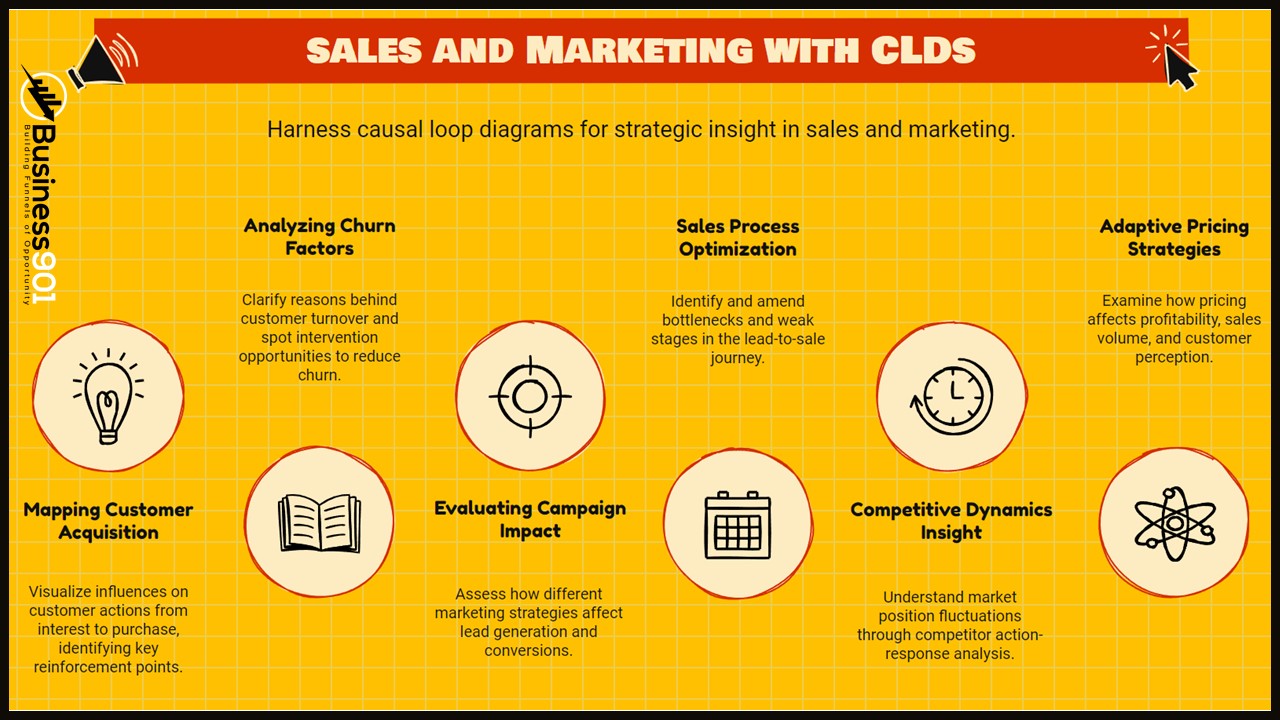To achieve long-term success in sales and marketing, you need to think beyond tactics and into interconnected forces. Causal loop diagrams provide a visual framework for understanding these dynamics, helping you make more informed strategic decisions. Unlock a new level of insight with these powerful diagrams. Here are several different ways to use CLD’s in your efforts:
- Understanding Customer Behavior
- Customer Acquisition Loop: Map the factors influencing customer interest, decision-making, and purchase. Identify reinforcing loops (positive feedback) that lead to repeat business and negative factors that impede acquisition.
- Customer Churn Loop: Analyze why customers leave, pinpoint reasons for dissatisfaction, and identify where interventions could prevent churn.
- Analyzing Campaign Performance
- Campaign Effectiveness Loops: Chart the impact of various marketing initiatives (advertising, promotions, content marketing) on lead generation, conversion rates, and overall sales. Isolate what works and what doesn’t.
- Viral Marketing Loops: Understand how and why certain campaigns achieve viral spread, mapping elements like social sharing, incentives, and reach that encourage amplification.
- Sales Process Dynamics
- Lead Nurturing Loop: Visualize the lead qualification, engagement, and conversion process. Identify bottlenecks or stages where leads drop off and streamline the process.
- Sales Team Performance Loop: Examine the interplay between sales team morale, training, tools, and their impact on closing deals. Identify areas where support could boost performance.
- Market Analysis
- Competitor Dynamics Loop: Gain insights into how competitors’ pricing, product features, and marketing strategies influence your market position and how your actions impact theirs.
- Market Trend Response Loop: Map how your organization identifies emerging trends, adjusts offerings, and responds to customer preferences or market conditions shifts.
- Pricing Strategy
- Profitability Loop: Analyze how pricing decisions influence sales volume, revenue, costs, and overall profitability.
- Customer Perception Loop: Track how price points influence customer perception of value and willingness to buy.
- Brand Management
- Brand Reputation Loop: Illustrate how customer experiences, reviews, social media sentiment, and crisis management contribute to building or eroding brand reputation.
- Brand Awareness Loop: Map how specific marketing channels, campaigns, and public relations efforts increase your brand’s reach and recognition.
Additional Considerations:
- CLDs are best used to model specific aspects of sales and marketing. Don’t try to put everything in one diagram.
- Involve stakeholders like sales reps or marketing managers to ensure realistic modeling of the processes and relationships.
Causal loop diagrams might seem simple, but their ability to illuminate complex relationships within your sales and marketing processes is remarkable. By understanding these dynamics, you gain the power to make strategic decisions that lead to growth.

